Edmonton International Airport
| Edmonton International Airport | |||||||||||||||
|---|---|---|---|---|---|---|---|---|---|---|---|---|---|---|---|
 | |||||||||||||||
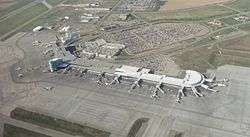 | |||||||||||||||
|
IATA: YEG – ICAO: CYEG – WMO: 71123 | |||||||||||||||
| Summary | |||||||||||||||
| Airport type | Public | ||||||||||||||
| Owner | Transport Canada | ||||||||||||||
| Operator | Edmonton Airports | ||||||||||||||
| Serves | Edmonton Capital Region, Alberta | ||||||||||||||
| Location | Leduc County, near Leduc, Alberta | ||||||||||||||
| Hub for |
| ||||||||||||||
| Focus city for | |||||||||||||||
| Time zone | MST (UTC−07:00) | ||||||||||||||
| • Summer (DST) | MDT (UTC−06:00) | ||||||||||||||
| Elevation AMSL | 2,373 ft / 723 m | ||||||||||||||
| Coordinates | 53°18′36″N 113°34′46″W / 53.31000°N 113.57944°WCoordinates: 53°18′36″N 113°34′46″W / 53.31000°N 113.57944°W | ||||||||||||||
| Website | www.flyeia.com | ||||||||||||||
| Map | |||||||||||||||
 CYEG Location within Alberta | |||||||||||||||
| Runways | |||||||||||||||
| |||||||||||||||
| Statistics (2014-2015) | |||||||||||||||
| |||||||||||||||
|
Sources: Canada Flight Supplement[1] Environment Canada[2] Movements from Statistics Canada[3] Passengers from Edmonton Airports.[4] | |||||||||||||||
Edmonton International Airport (IATA: YEG, ICAO: CYEG) is the primary air passenger and air cargo facility in the Edmonton region of the Canadian province of Alberta.
It is a hub facility for Northern Alberta and Northern Canada. It is Canada's largest major airport by total land area,[5][6] the 5th busiest airport by passenger traffic and by aircraft movements.[3][4] Operated by Edmonton Airports and located 14 nautical miles (26 km; 16 mi) south southwest[1] of downtown Edmonton in Leduc County on highway 2 opposite of the city of Leduc. it served 7,981,074 passengers in 2015.[7]
History
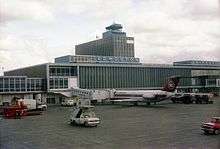
Transport Canada selected the current site for Edmonton International Airport and purchased over 7,000 acres (28 km2) of land. When the airport opened on November 15, 1960,[8] its first terminal was an arch hangar. Today, it is in use by L-3 Communications. In 1963, a passenger terminal, built in the international style, was opened. It remains in use as the North Terminal. Artwork, fired by Alberta Natural Gas, adorned the departures area exterior. A large mural, commissioned by the Canadian government in 1963 for CAD$18,000 titled "Bush Pilot in Northern Sky" by Jack Shadbolt, remains to this day. An appraisal in 2005 indicated that the mural was worth $750,000, and a restoration of the mural was undertaken in 2007.
During the 1970s, the airport experienced a rapid growth in traffic as the city of Edmonton grew, and served approximately 2 million passengers by 1980. However, from the early 1980s until 1995, traffic declined. This decline was attributed to the continued usage of Edmonton City Centre Airport as well as to a slowing economy. Edmonton City Centre did not have the facilities to accept large wide bodied long haul aircraft, thus airlines used City Centre to fly short-haul flights to hubs in other cities where connections to many locations were available.
Growth returned in 1995. In a municipal plebiscite in that year, 77% of voting Edmontonians voted to consolidate all scheduled jet passenger service at Edmonton International Airport.[9]
In 1998, the airport underwent a $282 million "1998–2005 Redevelopment Project".[10] The three-phase project included the construction of a south terminal and central hall concept, a commuter facility, doubling of the apron, and a multi-storey parkade. This redevelopment project expanded the passenger capacity to 5.5 million.
By the time the expansion project was completed in 2005, continued passenger growth triggered planning for another expansion.[11] A new 107,000-square-foot control and office tower was added in 2009.[12]
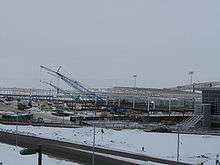
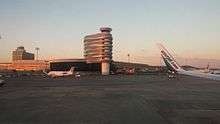
Further expansion was completed in 2013. Expansions have increased terminal capacity, improved the passenger experience through introduction of travelators, lounges, and retail, increased the number of gates available for aircraft and improved apron capacity among other improvements. Functional highlights include seven new passenger gates, 14 boarding bridges, six new elevators and moving walkways, over 100 security doors, and advanced baggage handling and scanning systems. Incremental improvements like improving de-icing capacity and implementing common use systems for airlines were also delivered. The Renaissance Hotel and the iconic snow-drift inspired control and office tower are recent major additions to the airport landscape.
In 2015, the Edmonton International Airport began twinning Highway 19, a project expected to be completed by 2018. The realignment of the highway will allow for the airport to finalize engineering and begin construction on the airport's third runway - runway 11/29. Runway 11/29, upon completion, is planned to be 3,530 m (11,580 ft) long.[13] Edmonton International Airport also plans to extend the existing Runway 12/30 by one-third its current length from 3,100 m (10,200 ft) to 4,030 m (13,220 ft) to increase accessibility and capacity.[14]
Airline service

EIA is one of WestJet's largest focus cities: the airline flies to 27 destinations with 46 daily departures, non-stop, from Edmonton. WestJet is the largest carrier at Edmonton International Airport, holding more than 50% of the market share.[15] Edmonton is also a focus city for flag carrier Air Canada and Air Canada Express, which, combined, operate to 10 destinations.
Canadian North and First Air connect their northern networks through Edmonton.[16][17]
New airline service
WestJet inaugurated it's seasonal service to London Gatwick from Edmonton in May 2016.
On September 25th 2015, Air China Cargo inaugurated its flight to Edmonton from Shanghai and Dallas/Fort Worth, with return flights to Shanghai making a stop in Tianjin. On November 3rd 2016, Air China Cargo began service to Chicago from Edmonton.
On December 19, 2015 Delta Air Lines began daily non-stop service to Seattle/Tacoma operated by SkyWest Airlines doing business as Delta Connection.
On July 25 2016, NewLeaf began operating non-stop flights from Edmonton to numerous cities within Canada. The destinations served from Edmonton have been changing since the inaugural flights.
On September 5th 2016, Integra Air began operating a new route to Medicine Hat.[18]
Fort McMurray evacuation
The Edmonton International Airport played a major role during the Fort McMurray wildfire, operating as an Aerial Firefighting hub, Medevac Hub and Evacuation hub. The Airport also became a way-station and temporary shelter for thousands of Fort McMurray evacuees. The Emergency Operations Centre in the airport ran for 112 hours, organizing the arrival and departure of hundreds of aircraft — the longest in the EIA’s history.
During the month of May, the airport saw more than 300 additional daily flights on top of their regularly scheduled service. The airport normally handled some 400 aircraft per day, but the evacuation caused airport officials to handle more than 700 aircraft daily. According to the airport's operational manager, most aircraft were "wingtip to wingtip." This caused delays to regular airline service by 10 to 20 minutes, and overall waiting times to increase by 10–15 minutes.[19]
Facilities
Passenger Facilities
EIA offers US Border Pre-clearance facilities.[20] Passengers from domestic flights connecting in Edmonton to a US destination use EIA's Quick Connect, which relieves passengers from having to claim and recheck baggage during the connection, and the passenger just has to clear security and US Customs and Border Protection before proceeding to their departure gate.
The four-star Renaissance Edmonton Airport Hotel is attached to the terminal.[21]
Airline Lounges
EIA offers an Air Canada Maple Leaf Lounge and two Plaza Premium lounges.[22][23]
Aircraft Facilities
EIA can handle aircraft designated as Code F by the ICAO (the Boeing 747-8 and the Airbus A380), and has been approved by airline as a diversion airport for the A380. They can be accommodated at gates 78, 80, 82 or 84 in the US departures area if the adjacent gates are not in use.[24] Such a diversion has happened at least once thus far.[25]
Air-cargo Facilities
In January 2015, Edmonton-based trucking company Roseneau Transport, unveiled its plan to open a new 210,000 square feet (20,000 m2) distribution centre and warehouse at the airport in November 2015. The facility, custom-built by Panattoni Development Company, will be a hub between the company’s ground cargo and its new venture of air freight and will give Western Canadian shippers the ability to send cargo to Edmonton that can be put on a plane to any destination within 24-hours.[26]
Additional air cargo expansion at the airport includes:
- Cargojet upgauged its existing Edmonton service from a Boeing 757-F to a wide-body Boeing 767-300, increasing both payload and volume for businesses to ship more, heavier, larger goods.
- DHL Express launched a new commercial wide-body route to Edmonton that arrives earlier and leaves later, providing regional business with increased access to express shipping.
- Braden-Bury Expediting (BBE) is now located in the same building as Canada Border Services Agency; with 40,000 square feet of warehouse space and convenient access to customs processing, which will help expedite the flow of goods to and from the Edmonton region.
- EIA has expanded Cargo Apron Seven to accommodate two additional code F aircraft (the largest variant). Additional operating and storage areas have been incorporated, including aircraft nose tethers.
- EIA upgraded its ground handling equipment with a new, 2014 Commander 60 main deck loader, eight 20-foot dollies and a 20-foot drive-over scale; the airport can, and regularly does, handle the world’s largest cargo aircraft - The Antonov An-225 & Boeing 747-8[27]
Emergency and policing
Edmonton International Airport Emergency Response Services provides fire services from one station with five tenders/pumpers and additional assistance from the Leduc County Fire Services with an additional pumper on site.
Policing is provided by the Royal Canadian Mounted Police's Airport Detachment.
Day to Day security is provided by Garda.
Regional air traffic control
The Edmonton Area Control Centre (ICAO: CZEG) operated by Nav Canada is located at the airport. It is responsible for all aircraft movements over Alberta (including Calgary) and most of northern Canada, including the high Arctic.
Airline Operational Facilities
Northern carrier Canadian North maintains its operations facilities at EIA.[28][29]
Market
EIA has a catchment area encompassing Central and Northern Alberta, northern British Columbia, and Yukon and the Northwest Territories. Total catchment area is 1.8 million residents.[30]
EIA is located within the Edmonton Capital Region, close to the towns of Devon and Beaumont, the city of Leduc, and adjacent to the Nisku industrial park. It is immediately west of the Queen Elizabeth II Highway, south of Highway 19, and 1.6 km (0.99 mi) north of Highway 39. Within this immediate radius of the terminal there are many full-service hotels and offsite parking lots complete with terminal shuttle service to offer a full range of services to the travelling public.[31][32][33][34]
Business passenger traffic is generated by a regional banking and financial cluster and major pension and wealth fund managers, provincial government operations, oilfield service businesses, a major Canadian research university (the University of Alberta), petrochemical, biotechnology, and real estate operations located in Edmonton and area.[35]
Outbound leisure passenger traffic is driven by high average disposable income in Edmonton.[36] Inbound leisure passenger traffic is driven by major tourist destinations in Edmonton such as West Edmonton Mall, the Edmonton Fringe Festival and nearby Jasper National Park.
Airlines and destinations
Passenger
Edmonton International Airport provides scheduled non-stop flights to 52 destinations.[37]
- Notes
- ^1 : U.S. bound flights departing after 19:00, depart from the domestic terminal and do not use U.S. border preclearance.
- ^2 : This flight makes a stop between Edmonton and the listed destination. However, the airline does not transport passengers between Edmonton and intermediate stop.
Cargo
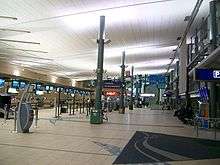
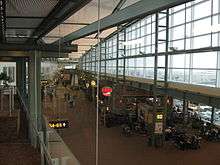
| Airlines | Destinations |
|---|---|
| Air China Cargo | Chicago, Dallas/Fort Worth, Shanghai–Pudong, Tianjin |
| Air France-KLM | Amsterdam |
| DHL Aviation operated by Southern Air | Calgary, Cincinnati |
| FedEx Express operated by Morningstar Air Express | Memphis, Toronto, Montreal |
| FedEx Feeder operated by Morningstar Air Express | Vancouver |
| Lufthansa Cargo | Frankfurt |
| Purolator Courier operated by Cargojet Airways | Hamilton, Winnipeg, Calgary |
In addition, Air Bridge Cargo, Korean Air Cargo, Atlas Air, Etihad Cargo and Lufthansa Cargo fly multiple charters to Edmonton year round.[39]
Other
The following airlines operate out of private facilities:
Statistics
Top destinations
| Rank | Airport | Passengers | Carriers |
|---|---|---|---|
| 1 | Phoenix–Sky Harbor | 195,369 | US Airways, WestJet |
| 2 | Las Vegas | 182,303 | WestJet |
| 3 | Houston-Intercontinental | 150,608 | United |
| 4 | Seattle/Tacoma | 138,775 | Alaska |
| 5 | Denver | 109,670 | United |
| 6 | Minneapolis/St. Paul | 105,995 | Delta |
| 7 | Cancun | 96,003 | Air Transat, Sunwing, WestJet |
| 8 | London-Heathrow | 93,564 | Air Canada |
| 9 | Los Angeles | 88,503 | WestJet |
| 10 | Chicago-O'Hare | 82,321 | United |
Annual traffic
| Year | Passengers | Year | Passengers | Year | Passengers |
|---|---|---|---|---|---|
| 2010 | 6,089,099 | 2000 | 3,843,321 | ||
| 2009 | 6,090,213 | 1999 | 3,700,016 | ||
| 2008 | 6,437,334 | 1998 | 3,791,574 | ||
| 2007 | 6,064,610 | 1997 | 3,720,623 | ||
| 2006 | 5,213,992 | ||||
| 2015 | 7,981,074 | 2005 | 4,511,452 | ||
| 2014 | 8,240,161 | 2004 | 4,081,565 | ||
| 2013 | 7,697,995 | 2003 | 3,882,497 | ||
| 2012 | 6,676,857 | 2002 | 3,773,800 | ||
| 2011 | 6,277,137 | 2001 | 3,940,416 |
Access
Public transit
Edmonton Transit System (ETS) provides express service between the Edmonton International Airport and the Century Park LRT Station, facilitating connections to the region's wider transit system. Route 747 runs between 4:10 a.m. and midnight every 30 minutes most times of the day. A one-way fare is C$5.00.[44][45]
Leduc Transit's Route 3 provides service between the airport and the city of Leduc.[46]
Airport shuttle
The SkyShuttle services the airport and selected stops in the city of Edmonton typically adjacent to major hotels. This service must be pre-booked by phone or online. The fare for this route is C$18.00 one way per adult as of 2012.[47]
Automobile
The airport is located adjacent to the Queen Elizabeth II Highway south of Edmonton.
Ground transportation to other cities
- Jasper National Park - coach service is offered daily.[48]
- Calgary - coach service is offered twice daily.[49]
- Red Deer - coach service is offered twice daily.[49]
- Cold Lake - connector bus is offered five times weekly.[50]
- Bonnyville - connector bus is offered five times weekly.[50]
- Smoky Lake - connector bus is offered five times weekly.[50]
Operating conditions
Weather
The weather station has been recording since 1961, at an elevation of 723 metres (2,372 ft) at 53°19′N 113°35′W / 53.317°N 113.583°W.[51] The Airport sees 77 days with rainfall, and 53 days with snowfall; in total the airport averages 446.1 millimetres (17.56 in) of precipitation per year. Daily average temperatures for the year are 3.9 °C (39.0 °F), and vary from 16.2 °C (61.2 °F) in July to −12.1 °C (10.2 °F) in January.[52] Daily maximums are 22.8 °C (73.0 °F) in July, and 6.3 °C (43.3 °F) in January.[52] The wind is predominantly from the South, with an average speed of 12.2 kilometres per hour (7.6 mph).[52] 13.3 days are at or above 30.0 °C (86.0 °F), and 12.6 are at or below −30.0 °C (−22.0 °F) per year.[52] Humidity stays steady through the year, from 79.3% at 06:00, to 56.3% at 15:00. 61.2 hours a year have visibility less than 1 kilometre (0.62 mi), and 8133.1 hours with more than 9 kilometres (5.6 mi) visibility. The airport receives 3210.1 hours of sunshine annually.[52]
Extremes
Extremes for the airport are; A record high of 35.6 °C (96.1 °F) on August 18, 2008,[53] and record low of −48.3 °C (−54.9 °F) on January 26, 1972.[52][54] The highest humidex reading was 38.7 on August 2, 1965, and the lowest wind chill at −61.0 °C (−77.8 °F) on January 26, 1972.[52] The maximum hourly speed record is 87 kilometres per hour (54 mph) on October 1, 1965,[55] and the strongest gust was 146 kilometres per hour (91 mph) on the same day.[52]
Appearances in Media
On October 5th 2016, the History Channel began airing a new series that revolves around the Edmonton International Airport, Airport: Below Zero. The show follows the airport's day-to-day operations and how the staff are able to keep the airport running smoothly, even during the extreme winter weather.[56]
Accidents and incidents
- On 2 January 1973, a Boeing 707-321C CF-PWZ of Pacific Western Airlines. A cargo flight of 86 cattle from Toronto, Ontario with five crew-members on board, was on approach to runway 30, visbility was poor with blowing snow, and turbulence. It struck the ground 3,137 metres (3,431 yd) short of runway 30.[57] Hitting trees, power-lines and a gravel ridge then erupted into fire. All five of the crew-members were killed in the crash including all cattle. The aircraft was damaged beyond economic repair.[58][59] No investigation was done so the crash cause is still unidentified.[58]
- On 6 November 2014, a Bombardier DHC-8-402 C-GGBF of Air Canada Express. A passenger flight from Calgary to Grande Prairie with 71 passengers and three crew-members, During take off the third tire of the main landing gear burst.[60] This caused a loud bang noise inside the plane.[61] Head winds prevented landing back in Calgary, so it was diverted to Edmonton International Airport.[62] During the landing the right main landing gear collapsed. The propellers on the right side of plane struck the ground and broke, one of the blades when though the cabin wall injuring three passengers.[60]
Commercial non-aviation operations
Premium Outlet Collection
In May 2015, an official groundbreaking ceremony was held for a new premium outlet mall by developer Ivanhoe Cambridge, which is to be located at the Edmonton International Airport. In early 2016, Ivanhoe Cambridge announced that Simon Property Group would partner with them in the construction, development and leasing of the mall, officially named Premium Outlet Collection - Edmonton International Airport.[63] Construction officially began in Spring 2016 on the more than 580,000 sq ft (54,000 m2) shopping mall. The mall will feature over 100 outlet stores, with many of them making their Canadian debut. As of October 2016, Premium Outlet Collection - EIA is on track to be completed by Fall 2017.[64]
Office and hotel park
Adjacent to the Edmonton Premium Outlets will be office buildings and hotels, located on the Queen Elizabeth II Highway at Airport Road.
References
![]() This article incorporates public domain material from the Air Force Historical Research Agency website http://www.afhra.af.mil/.
This article incorporates public domain material from the Air Force Historical Research Agency website http://www.afhra.af.mil/.
- 1 2 Canada Flight Supplement. Effective 0901Z 15 September 2016 to 0901Z 10 November 2016
- ↑ Meteorological data
- 1 2 "Total aircraft movements by class of operation — NAV CANADA towers". Statistics Canada. July 14, 2015. Retrieved July 25, 2015.
- 1 2 "Edmonton International Airport Traffic Statistics 2014-2015" (PDF). flyeia.com. Retrieved May 10, 2016.
- ↑ "Facts and Statistics". EIA. Retrieved June 16, 2015.
- ↑ "Welcome to Edmonton Airports Corporate Information Site". EIA. 2014.
- ↑ "2015 Public Report" (PDF). EIA. Retrieved May 10, 2016.
- ↑ "EIA History". Edmonton International Airport. Retrieved November 10, 2015.
- ↑ "Edmonton City Centre Airport to Continue Serving Capital Region". Edmonton Airports. November 18, 2003. Retrieved January 26, 2012.
- ↑ "Continuous passenger growth spurs facilities review at Edmonton International Airport". Edmonton Airports. April 21, 2006. Retrieved January 26, 2012.
- ↑ "Edmonton Airports – Air Terminal Project (2005–1998)". Archived from the original on August 21, 2007. Retrieved January 26, 2012.
- ↑ "Journal Of Commerce - Edmonton International Airport gets new traffic control tower". Retrieved August 10, 2015.
- ↑ EIA Masterplan - Runway 11/29
- ↑ http://corporate.flyeia.com/about-us/reports-publications/eia-master-plan
- ↑ Passenger numbers stable in Canada in Q1; Ottawa only top 10 airport growing at more than 5%; Demand up at Air Canada and WestJet. anna.aero. Retrieved on April 23, 2011.
- ↑ Canadian North Flight Schedule and Interactive Flight Map.
- ↑ "Route Map". First Air.
- ↑ http://medicinehatnews.com/news/local-news/2016/08/27/ceremony-marks-new-flights-to-edmonton/
- ↑ http://edmontonjournal.com/news/local-news/more-than-300-extra-flights-squeezed-into-edmonton-airports-regular-operations.
- ↑ "Preclearance Locations". U.S. Customs and Border Protection. Archived from the original on 2013-02-15. Retrieved January 26, 2012.
- ↑ "Renaissance Edmonton Airport Hotel". Marriott Hotels and Resorts. Retrieved June 16, 2015.
- ↑ "Plaza Premium Lounge | Edmonton International Airport". Flyeia.com. Retrieved 2016-05-24.
- ↑ "Lounge Locations - Maple Leaf Lounges". aircanada.com. 2014-11-14. Retrieved 2016-05-24.
- ↑ "Edmonton International Airport Technical Data Guide" (PDF). March 2013.
- ↑ "Lufthansa A380 Emergency landing" on YouTube
- ↑ "New airport outlet mall and cargo centre brings $225M investment". CBC News. January 21, 2015. Retrieved 2015-06-16.
- ↑ "Edmonton International Airport Cargo Village delivers continued strong cargo growth in 2014 | EIA Corporate". Corporate.flyeia.com. 2015-03-03. Retrieved 2016-05-24.
- ↑ "Administration" (Archive). Canadian North. Retrieved on March 21, 2014. "Operations Office - Edmonton 101 – 3731 52 Avenue East Edmonton AB T9E 0V4 Canada"
- ↑ "Kearl Information Letter" (PDF). Boilermakers Local 146. Archived from the original (PDF) on March 21, 2014. Retrieved June 16, 2015.
Canadian North Charter Terminal, 3731 52 Ave E. Edmonton International Airport, AB. T9E 0V4
- ↑ "Edmonton International Airport Market Profile" (PDF). Retrieved 2016-05-24.
- ↑
- ↑ Leduc County map
- ↑ "Maps - Edmonton International Airport". Edmonton Airports. Archived from the original on 2012-04-02. Retrieved January 26, 2012.
- ↑ Ground Transportation – Edmonton International Airport. Flyeia.com (February 28, 2011). Retrieved on April 23, 2011.
- ↑ "Industries :: City of Edmonton". Edmonton.ca. 2016-03-23. Retrieved 2016-05-24.
- ↑ "Economic indicators, by province and territory (monthly and quarterly) (Canada)". Statcan.gc.ca. 2016-05-20. Retrieved 2016-05-24.
- ↑ "Fly Non-Stop | Edmonton International Airport". EIA. 2016.
- ↑ http://www.bizjournals.com/phoenix/news/2016/11/16/breaking-phoenix-mesa-gateway-airport-lands-first.html/
- ↑ "Cargo Media | EIA Cargo". Cargo.flyeia.com. Retrieved 2016-05-24.
- ↑ "U.S. International Air Passenger and Freight Statistics Report". United States Department of Transportation. March 25, 2014.
- ↑ "UK Airport Statistics". Civil Aviation Authority.
- ↑ "Estadística Mensual Operativa / Monthly Operating Statistics". Secretaría Dé Comunicaciones Y Transportes. March 4, 2014. Archived from the original on 2015-01-02.
- ↑ "Passenger Statistics". Retrieved August 10, 2015.
- ↑ "Route 747 Bus Service". City of Edmonton. Retrieved June 16, 2015.
- ↑ "Bus service to airport starts Sunday". CBC News. April 26, 2012. Retrieved May 30, 2012.
- ↑ "Route 3". Leduc Transit. September 2, 2014.
- ↑ "Rates - Edmonton Skyshuttle". Edmonton Skyshuttle. Edmonton Taxi Service Group. Retrieved December 23, 2012.
- ↑ "Edmonton Edson Hinton Jasper Shuttle Service". Sundogtours.com. 2014-06-20. Retrieved 2016-05-24.
- 1 2 "ebus Non–stop to Edmonton International Airport" (PDF). EIA. Retrieved 2016-05-24.
- 1 2 3 "Cold Lake to Edmonton & YEG" (PDF). Red Arrow Connector. Retrieved 2016-05-24.
- ↑ "Station Results - Historical Data". Environment Canada. Government of Canada. Retrieved 22 May 2016.
- 1 2 3 4 5 6 7 8 "Temperature and Precipitation Graph for 1981 to 2010 Canadian Climate Normals - EDMONTON INT'L A". Environment Canada. Govnment of Canada. Retrieved 22 May 2016.
- ↑ "Hourly Data Report for August 18, 2008". Environment Canada. Environment Canada. Retrieved 22 May 2016.
- ↑ "Hourly Data Report for January 26, 1972". Environment Canada. Environment Canada. January 26, 1972. Retrieved 22 May 2016.
- ↑ "Hourly Data Report for October 01, 1965". Environment Canada. Environment Canada. Retrieved 22 May 2016.
- ↑ http://www.history.ca/series-news/latest/new-series-airport-below-zero/
- ↑ McNaughton, Nerissa. "Edmonton International Airport: A Constant Evolution" (PDF). Business in Edmonton. Edmonton International Airport: BBE. p. 2. Retrieved 21 August 2016.
- 1 2 "Tuesday 2 January 1973". Aviation Safety Network. Flight Safety Foundation. Retrieved 21 August 2016.
- ↑ Kebabjia, Richard. "1973 Edmonton Accident". Plane Crash Info. Richard Kebabjia. Retrieved 21 August 2016.
- 1 2 "Aviation Investigation Report A14W0177". Transportation Safety Board of Canada. Government of Canada. Retrieved 27 August 2016.
- ↑ Ha, Tu Thanh (9 November 2014). "Air Canada crash landing in Edmonton was more serious than first reported". The Globe and Mail Inc. The Globe and Mail. Retrieved 27 August 2016.
- ↑ Bateman, Tom. "Allen recounts Air Canada flight". un Media Community Newspapers. Grande Prairie Daily Herald-Tribune. Retrieved 27 August 2016.
- ↑ http://ivanhoecambridge.com/en/news-and-media/news/2016/01/outlet-eia
- ↑ http://corporate.flyeia.com/node/672817
External links
| Wikimedia Commons has media related to Edmonton International Airport. |
- EIA (Edmonton International Airport) homepage
- Fly Edmonton Campaign
- Canadian Owners and Pilots Association Places to Fly Airport Directory page about Edmonton International Airport
- Past three hours METARs, SPECI and current TAFs for Edmonton International Airport from Nav Canada as available.